| GNSS | |

Galileo Technology Centre
|
||||
|
Today Satellite Based Navigation Services play an increasingly important role in modern society. The provision of the navigation, positioning and timing service provided by GPS is widely used. However, the system is under military control, and consequently legal guarantees of operation required by modern business cannot be given. On the other hand the market for GNSS related products is recognised as an important economic factor and service guarantees and liabilities will be needed. Accordingly, the European Commission (EC) and ESA jointly launched initiatives towards an independent European Galileo satellite constellation and associated augmentations and systems including the integration of the EGNOS service. The Galileo system will comprise state-of-the-art global positioning and timing service, integrity service, search and rescue (SAR) as well as commercial services that are still under study. With the architecture defined so far, Galileo will be interoperable with other services and service guarantees can be offered. Local operators may add a number of local services, such as local differential correction signals or availability augmentations. The quality of the signals is monitored by the ground segment and corresponding integrity messages are broadcasted via the Galileo satellites for safety-of-life applications. Orbit ephemeris and clock synchronisation are calculated from measurements made by a worldwide network of stations. The space segment consists of a constellation of 30 satellites (27 + 3 in-orbit spares) distributed over 3 orbital planes in MEO altitudes. As the outcome of the In-Orbit- Validation Phase, there will be 4 Satellites and the associated ground segment to provide initial operations from 2008 onward. The Galileo Full Operational Capability is expected to be achieved 2 years later[1]. Based on the Galileo Services there will arise various downstream applications and value added services on global, regional and local levels. It is expected that along with these services there will also arise the need to provide Galileo service performance information and analysis. In the Galileo project it is planned to give to independent regional Galileo Service Centres access to the Galileo Ground Control Centres (via the Service Provision Facility – SPF) as e.g. pointed out in [2]. Thales and NavPos have jointly started an initiative, supported by the German Aerospace Centre (DLR) to develop a technical facility to satisfy these needs and to support the introduction of Galileo worldwide. This development is called GalTeC – Galileo Technology Centre and could be viewed as one of the downstream Galileo Service Centres. GalTeC missionThe basic scope of GalTeC is to provide services related with the provision of Galileo satellite-only services through the Galileo Operating Company (GOC). However it will also provide services linked to the other GNSS systems – GPS, GLONASS as well as EGNOS. The services will comprise on the one hand, recent and past GNSS function and performance monitoring and on the other hand prediction capability about the near future situation in GNSS services. Today there are already several such services offered for GPS from different sources. The GalTeC philosophy is understood as a single source for such bundled GNSS information provision but with main focus on Galileo. Such that the GalTeC can be found logically between the Galileo Systems (plus other GNSS) and the End User on one hand, also between Galileo System and downstream Commercial Service provider on the other hand. The latter can also be SAR service providers as well as Galileo Regional Integrity providers. For example the Regional Integrity providers would need to assess which Galileo satellites over the Region can transmit the data with which elevations for which time frame. GalTeC architectureThe GalTeC architecture will basically consist of a scalable server/client architecture with several computer systems on which the different softwarebased functions will be realised. The basic HW mounted in a single 19′ rack consists of the three GalTeC servers with integrated mass storage. The various analysis and evaluation software on the GalTeC servers need access to the Internet in order to download actual data from various sources delivering GNSS measurement and evaluated data. The external access to GalTeC is given through the dedicated GalTeC Internet Server. For security reasons the GalTeC Internet services are actually not provided by the GalTeC main server itself. The GalTeC will be connected internally to local users with own working stations for performing individual computations. There will also be one workstation direct at the location of the server. Finally it is planned to foresee a connection to the Galileo Ground Segment via its Service Centre Interface, or to a dedicated Central Galileo Service Centre. Also GalTeC is planned to finally act as one of the first Galileo Service Centres. GalTeC will provide the following features: Prediction and Service Volume SimulationPerformance prediction using a service volume simulation tool based on ephemeris or almanacs Analysis and Products Independent calibration of the major Galileo/ GNSS system parameters (satellite force models, satellite clock models, propagation models, processing models etc.) The development of the related Software packages are performed jointly by Thales and NavPos systems, where the latter is fully responsible for the Simulation (or Prediction) package. The GNSS measurements are used to generate high precision reference data, i.e. Precise Satellite Orbits and Clocks in SP3 format. These are then used to determine Orbit and Clock errors on the basis of GNSS broadcast ephemeris. In parallel the Simulation or Prediction tool uses the collected original broadcast ephemeris and almanac to compute out of the satellite geometry the PVT quality factors for a time and area window. To choose the correct model – input parameters are needed out of the analysis in a back loop for e.g. a single position (that of the reference station). The Analysis functions will then analyse the computed results from the Reference module and present the analysis results in a more visual way (e.g. a classical trade-off: Is vs. Shall vs. Prediction). Then the services functions will be used to generate then the different reports with integrated graphics and final results in usual formats (ASCII, XML, PDF,…).Figure 4 shows the interaction of the main GalTeC modules. |
||||


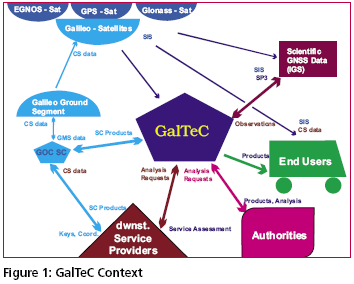
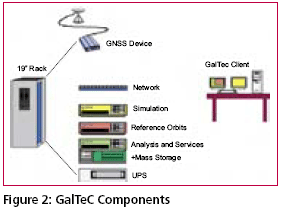
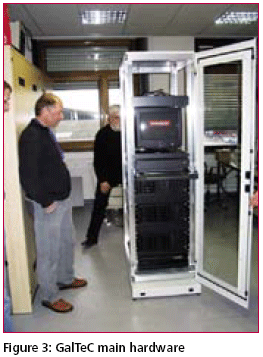
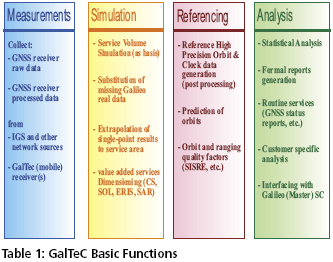
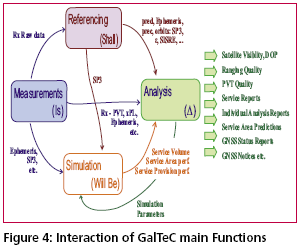










 (No Ratings Yet)
(No Ratings Yet)





